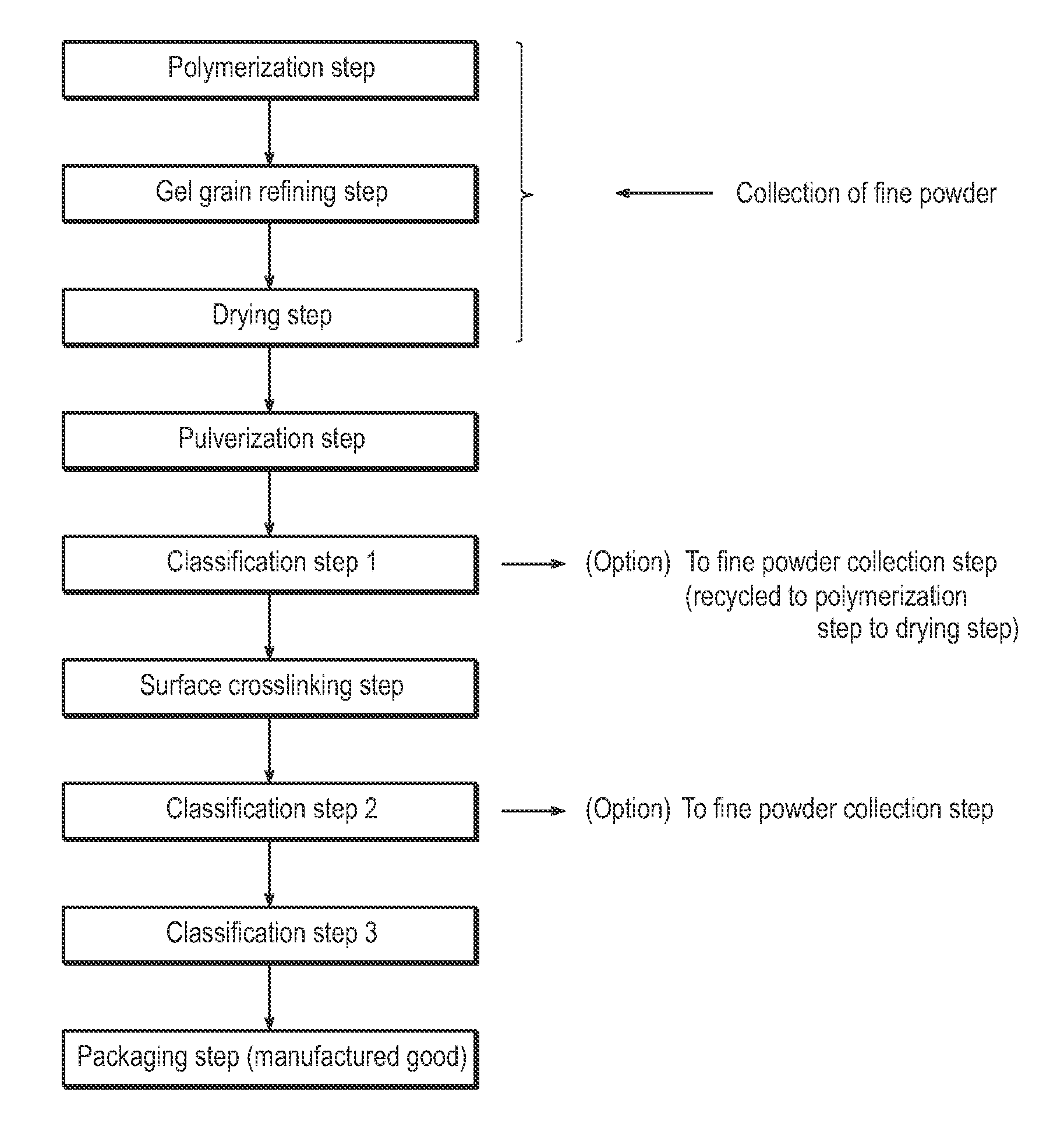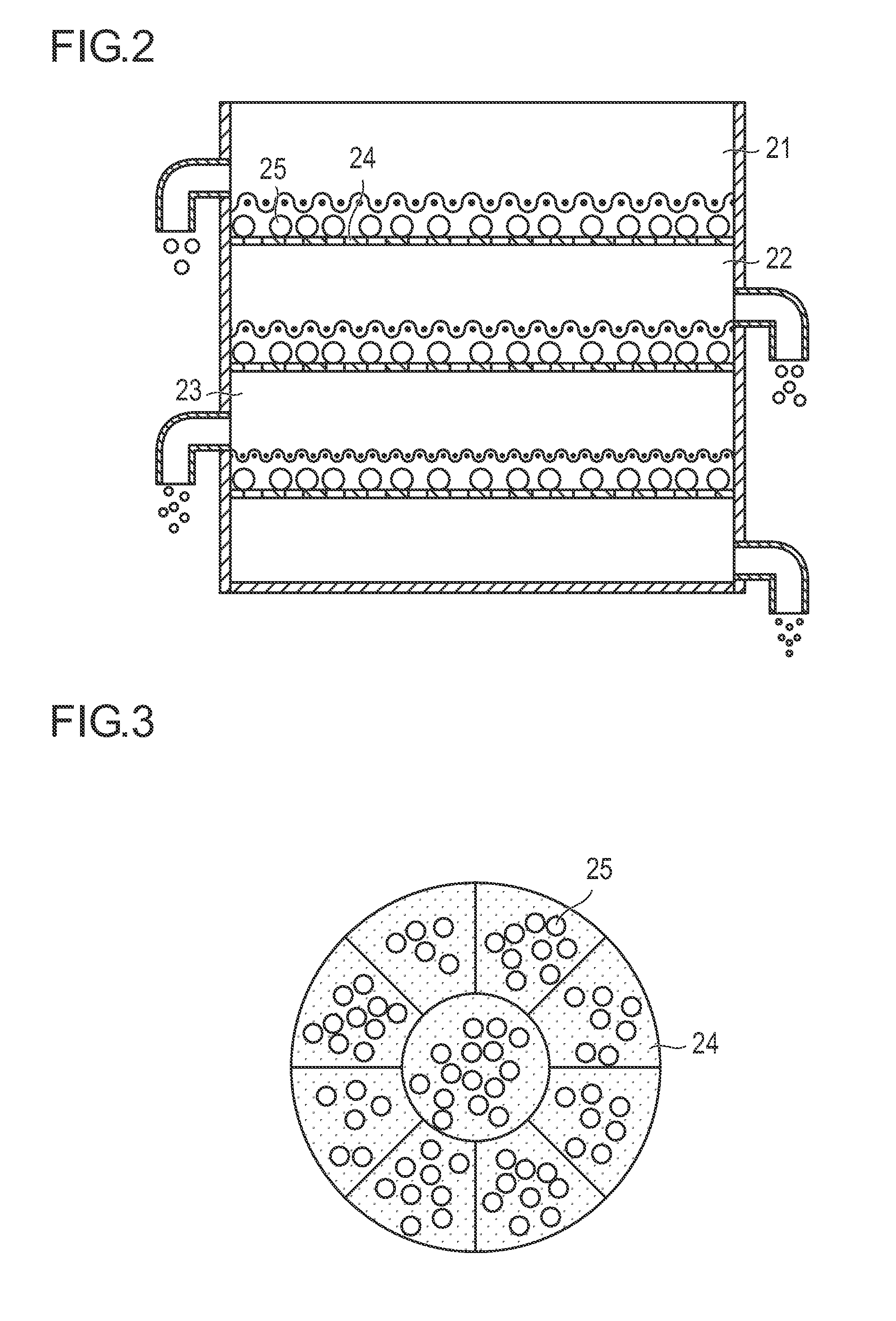Method of producing water absorbent resin
a technology of water absorption resin and water absorption chamber, which is applied in the direction of filtration separation, separation processes, instruments, etc., can solve the problems of increased cost, increased production cost, and decreased physical properties, so as to reduce the deviation of physical properties during continuous production or the deterioration of physical properties resulting from continuous operation
- Summary
- Abstract
- Description
- Claims
- Application Information
AI Technical Summary
Benefits of technology
Problems solved by technology
Method used
Image
Examples
example 1
[0318]The same operation as that employed in Comparative Example 1 was carried out, except that in relation to the particle size regulation step (classification step 2) of Comparative Example 1 described above, white (milky white) tapping balls (made of a urethane resin; ratio of the cross-section of the tapping balls to the area of the metal sieve mesh: 16%) having a diameter of 30 mm and a punching metal (hole ratio: 40%) made of stainless steel (material: SUS304) having a hole diameter of 20 mm were installed below the metal sieve (mesh opening size: 850 μm). Thus, a water absorbent resin (1) (moisture content: 1.5 wt %, extractables: 8.8 wt %, weight average particle size (D50): 450 μm, and 0.36) was obtained. The distance between the metal sieve and the punching metal was 50 mm. Furthermore, the temperature of the tapping balls in the classification step 2 was about 60° C. (heating equilibrium temperature of hot air, the sieve surface, and the water absorbent resin).
[0319]While...
example 2
[0321]The same operation as that employed in Comparative Example 2 was carried out, except that in relation to the classification step 2 of Comparative Example 2 described above, white (milky white) tapping balls (made of a urethane resin; ratio of the cross-section of the tapping balls to the area of the metal sieve mesh: 16%) having a diameter of 30 mm and a punching metal (hole ratio: 40%) made of stainless steel (material: SUS304) having a hole diameter of 20 mm were installed below the metal sieve (mesh opening size: 850 μm). Thus, a water absorbent resin (2) (moisture content: 1.5 wt %, extractables: 8.7 wt %, weight average particle size (D50): 441 μm and σζ: 0.37) was obtained. The distance between the metal sieve and the punching metal was 50 mm. Furthermore, the temperature of the tapping balls in the classification step 2 was about 60° C. (heating equilibrium temperature of hot air, the sieve surface, and the water absorbent resin).
[0322]While the water absorbent resin (2...
example 3
[0337]The same operation as that employed in Comparative Example 4 was carried out, except that in relation to the classification step 2 of Comparative Example 4 described above, white (milky white) tapping balls (made of a urethane resin; ratio of the cross-section of the tapping balls to the area of the metal sieve mesh: 16%) having a diameter of 30 mm and a punching metal (hole ratio: 40%) made of stainless steel (material: SUS304) having a hole diameter of 20 mm were installed below the metal sieve (mesh opening size: 710 μm). Thus, a water absorbent resin (3) (moisture content: 1.4 wt %, extractables: 6.3 wt %, weight average particle size (D50): 401 μm, and 0.36) was obtained. The distance between the metal sieve and the punching metal was 50 mm. Furthermore, the temperature of the tapping balls in the classification step 2 was about 60° C. (heating equilibrium temperature of hot air, the sieve surface, and the water absorbent resin).
[0338]While the water absorbent resin (3) o...
PUM
| Property | Measurement | Unit |
|---|---|---|
| area | aaaaa | aaaaa |
| temperature | aaaaa | aaaaa |
| surface roughness | aaaaa | aaaaa |
Abstract
Description
Claims
Application Information
 Login to View More
Login to View More - R&D
- Intellectual Property
- Life Sciences
- Materials
- Tech Scout
- Unparalleled Data Quality
- Higher Quality Content
- 60% Fewer Hallucinations
Browse by: Latest US Patents, China's latest patents, Technical Efficacy Thesaurus, Application Domain, Technology Topic, Popular Technical Reports.
© 2025 PatSnap. All rights reserved.Legal|Privacy policy|Modern Slavery Act Transparency Statement|Sitemap|About US| Contact US: help@patsnap.com



